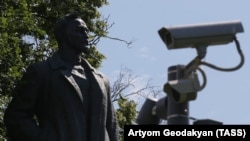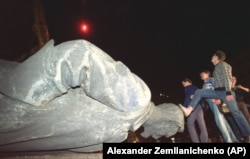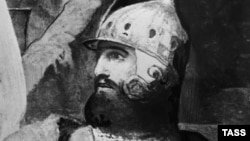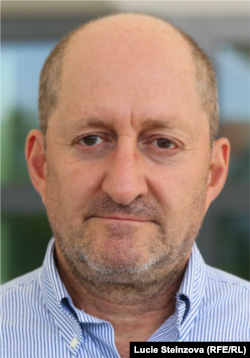To receive Steve Gutterman's Week In Russia via e-mail, subscribe by clicking here. In the coming weeks, we'll be updating the formatting of this newsletter, so don’t be surprised if it looks slightly different. And please check your spam folder if you don’t receive it. If you have thoughts or feedback, you can reach us directly at newsletters@rferl.org.
There were two iconic moments in the abortive August 1991 coup whose failure hastened the collapse of the Soviet Union -- three if you count the telling press conference of the plotters, with self-declared "acting president" Gennady Yanayev's hands trembling as if he had steeled himself for the spotlight with some vodka shots.
One, of course, was Boris Yeltsin, recently elected president of Soviet Russia, standing defiantly on a tank outside parliament and calling for mass resistance against the putsch.
The other was the removal of the statue of "Iron Feliks" Dzerzhinsky, founder of the Bolshevik secret police, from the square that bore his name outside the headquarters of the KGB -- a towering and unmistakable symbol of the Soviet state's power over the people.
After a crowd of citizens celebrating the coup's collapse tried to tear down the 15-ton statue, a city crane arrived and pulled Dzerzhinsky off his pedestal.
The Soviet Union ceased to exist four months later, and with it the KGB -- the latest in a line of secret police agencies stretching back to 1917 and the All-Russia Extraordinary Commission to Combat Counterrevolution and Sabotage, which was known as the Cheka and was led by Dzerzhinsky.
In some parallel universe, the KGB might be a source of shame to the Russian government today, part of a Soviet past not forgotten but studied as a fount of information about how to avoid a repeat of repression.
Not so in this world, though: Vladimir Putin, a longtime KGB officer in the Soviet era and a former head of the Federal Security Service (FSB), its main domestic successor, has been president or prime minister since 1999. Last year, he engineered constitutional reforms allowing him to seek to remain president until 2036, a move that analysts said strengthened the already powerful security services.
Putin has brought numerous former colleagues from security, intelligence, and law enforcement agencies -- the so-called siloviki -- into top positions in the ruling elite.
As far back as December 1999, shortly before Yeltsin stepped down and made him president, Putin suggested -- with a smile to indicate he was joking -- that an FSB mission to take over the government had been succeeded.
And this week, after years of unheeded calls by nationalists steeped in Soviet nostalgia for the statue's return, a city-backed online vote got under way, with the result meant to determine whether Dzerzhinsky's likeness would once again stand in the center of what is now called Lubyanka Square -- a return to its pre-Revolutionary name.
Nevsky Or Dzerzhinsky?
Going up against Iron Feliks a century after his death was a figure from closer to a millennium ago: Aleksandr Nevsky, a medieval Prince of Novgorod best known for his role in the defeat of an advancing force of Teutonic knights and others on an icy lake in 1242.
But two days into the one-day vote in which only Muscovites were eligible, Moscow Mayor Sergei Sobyanin abruptly halted it late on February 26, saying that the issue had become too divisive and that “for now” the square would remain statue-free.
“Different points of view on history are unavoidable. But statues that stand on the streets and in the squares should unite society, not split it apart,” Sobyanin said in a statement posted on his website.
The mayor’s sudden announcement was a surprise; the fact that the prospect of restoring Dzerzhinsky’s statue to the square could be divisive should not have been.
If Dzerzhinsky were to be put back, it would be an almost laughably obvious sign of the times -- "a warning to society of the resources available of the state should it choose to crack down, a reminder of how bad things could be, and…probably also a sop to the siloviki," Mark Galeotti, an author and expert on Russian security structures, said in a February 21 podcast.
"Because after all, the more the state depends on repression, the more it depends on the forces of repression," Galeotti said.
Dzerzhinsky's return would add a kind of a trolling flourish to events over the past decade and the past few weeks.
In the past decade, Kremlin critics say, Putin has tightened the screws following protests in 2011-12 prompted in part by his return to the presidency after a stint as prime minister -- a decision that dashed the hopes of Russians eager for political change.
In recent weeks, the authorities have racked down hard on protests over the jailing of opposition leader Aleksei Navalny, who was arrested upon return from Germany after recuperating from a near-fatal poisoning he blames on Putin and has subsequently been sentenced to serve 2 1/2 years in prison.
More broadly, to some Russians the restoration of Dzerzhinsky’s statue to its former spot would be a substantial and startling reversal of some of the implications of the Soviet collapse -- a sign that few lessons have been learned.
"The footage of the statue being toppled in 1991 was symbolic of a revolution against the Soviet state," Andrei Kolesnikov, a senior fellow at the Carnegie Moscow Center and an expert on Russian politics, told The Moscow Times for an article published on February 25. "In restoring the statue, they are nullifying that revolution."
Sobyanin said that after two days of voting, Aleksandr Nevsky held a modest lead. Citing the website where the vote was recorded, the state-run news agency TASS reported that nearly 320,000 people had voted and that the medieval prince had 55 percent to Dzerzhinsky’s 45 percent.
But before it even started the abortive vote was emblematic on several levels. On a narrower scale, but one that will change the face of the Russian capital and the tenor of ties between the people and the state, it echoes several prominent elements of the Putin era.
Managed Democracy
Since Putin came to power, the Kremlin has pushed authentic opposition to the margins and used numerous levers to make elections as predictable as possible while maintaining a veneer of democracy.
Navalny, for example, was allowed to run in a Moscow mayoral election in 2013 and came in second behind the Kremlin-backed incumbent. But he was barred from challenging Putin for the presidency in 2018 due to a conviction on charges he contends were fabricated.
Like the elections held in Russia since 2000, the statue vote offers citizens a choice, but one that is limited in ways that seem certain to produce an outcome that is satisfactory for the Kremlin.
Since the toppling of the statue was a symbol of the defanging of the Soviet state and its security apparatus, one might have expected a dissident to face off against Dzerzhinsky, although there is a small monument to Gulag survivors on the square. Andrei Sakharov and Aleksandr Solzhenitsyn come to mind -- in that parallel universe, at least.
No such figure was apparently considered, and a few other potential contenders were cast aside in favor of a one-on-one contest between Dzerzhinsky and Aleksandr Nevsky.
Selective Memory
If you think the juxtaposition makes little sense -- a 20th-century political-police chief and a 13th-century prince -- think again. Or think of it from Putin's point of view: He has constantly used imagery selected from various periods of the country's past, analysts say, to project power and foster patriotism.
Far from shunning the Soviet era in favor of tsarist times, he has evoked portions of it repeatedly and is accused by critics of conniving with the creeping rehabilitation of Soviet dictator Josef Stalin.
The bloodiest portion of Stalin's long rule was the Great Terror, the murderous purges that hit their height in 1937-38. Dzerzhinsky's Cheka carried out the Red Terror, a deadly campaign of political repression in 1918-22, mostly during the Russian Civil War that followed the Bolshevik Revolution.
Dzerzhinsky was "clearly a ghastly zealot who not only presided over terror but created the initial machine that Stalin would in due course expand into his industrial generator of mass terror," Galeotti said on his podcast.
But in Putin's Russia, he has been cast as a symbol of law and order -- and even as a protector of children, with attention focused on his role in the establishment of a system of orphanages.
For those who want Dzerzhinsky back, part of the appeal lies in the idea that for them, the Soviet collapse was not the welcome end of an experiment that subjected millions to deprivation and unfreedom for decades but the humiliation of a mighty country and the start of years of economic and political uncertainty.
"The removal of Dzerzhinsky in 1991 is a symbol of the collapse of Russia, the collapse of an empire (sure, it was Soviet, but it was ours, of course), the collapse of everything we are trying to return, renew, and reanimate: social guarantees, order, security, and sovereignty," Zakhar Prilepin, a nationalist writer who has pushed for the statue's return, wrote on Facebook.
Divide And Rule
Those four terms fit well with what Putin says are crucial elements in a thriving Russia, and the one that he promises the people. But it was far from clear that he wants Dzerzhinsky back on Lubyanka Square -- and the fact that the vote was stopped with that outcome seemingly within reach may add to the evidence that he does not, even though the result so far seemed unsurprising.
For one thing, returning Dzerzhinsky would be coming down hard in favor of a man Galeotti said was an "absolutely central figure to the Red Terror."
"Now it's impossible to put him back on his plinth, in his square, and not regard that as a rehabilitation of the past horrors," he said.
However marginalized Russian liberals may be, Putin could be concerned that the message would be needlessly divisive.
Perhaps more important, it would be a boost for the siloviki -- the security and law enforcement apparatus -- at a time when their position already seems particularly strong. That might not fit well with the calculations of Putin, who analysts say likes to play different camps in the ruling elite against one another and to avoid handing any single group too much clout.
It would also risk placing too much emphasis on the Soviet Union and the revolution that brought it into being. Putin is no fan of revolutions -- because he does not want the kind of protest-driven political change that has occurred in Ukraine, Georgia, and other ex-Soviet republics to be repeated in Russia -- and has repeatedly criticized Lenin.
Plus, putting too much weight on a figure from the Soviet era might undermine Putin's efforts to cast himself as a leader who is responsibly bearing Russia into the future, not carrying it back to the troubled 20th century.
That was where Aleksandr Nevsky seemed to come in handy. To some people with a deeper knowledge of history he has his own drawbacks, and is hardly a Russian hero.
But unlike Dzerzhinsky, who has been dead less than a century and who played a large part in the establishment of the Soviet state that lives in the memory of the many millions of Russians born before it collapsed 30 years ago, he is an almost mythical figure from the distant past -- depicted in paintings in plated armor and on icons in an ermine stole.
His image -- built largely on the much-ballyhooed battle against forces charging toward Novgorod from the west -- dovetails well with Putin's efforts to portray himself as a leader defying persistent pressure from the West.
"Nevsky fits perfectly within the kind of Putinist pantheon of figures who were competent and ruthless -- but above all they were active in advancing the interests of the state that would in due course become Russia," Galeotti said.
Both statue candidates "are perceived as essentially patriotic, anti-Western figures that chime well with the Kremlin's present ideology," Kolesnikov told The Moscow Times. "Dzerzhinsky symbolizes the return of the secret police's power, and Nevsky victory over Western invaders."
With the vote canceled, it seems highly unlikely that "Iron Feliks" will be restored to the spot where he stood from 1958 to 1991, a few years longer than the time that has passed since he was removed. But to Russians who thought returning his statue was unthinkable, the idea that such a debate could be happening at all is a punch in the gut.
"In fact, it is depressing that we are even discussing this topic," Sergei Stankevich, a liberal politician who was a Moscow city legislator in 1991 and helped oversee the statue's removal, told The Moscow Times.















